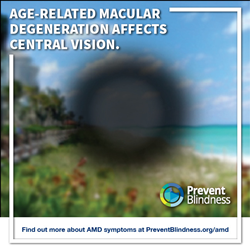
Prevent Blindness offers free educational materials for February’s Age-related Macular Degeneration and Low Vision Awareness Month.
“As our population ages, the number of people who are affected by vision loss will continue to climb,” said Jeff Todd, president and CEO of Prevent Blindness.
CHICAGO (PRWEB)
January 30, 2023
As part of February’s Age-related Macular Degeneration (AMD) and Low Vision Awareness Month, Prevent Blindness, the nation’s leading eye health and safety nonprofit organization, is offering free resources to the public to help educate and empower individuals, and their care partners, to make informed decisions about their vision and eye health.
AMD is an eye disease that is a leading cause of vision loss for Americans ages 50 and older. It affects central vision, where sharpest vision occurs, causing difficulty conducting daily tasks such as driving, reading, and recognizing faces. According to a new study leveraging the Centers for Disease Control and Prevention’s (CDC) Vision and Eye Health Surveillance System, “The Prevalence of Age-Related Macular Degeneration in the United States In 2019,” more than 19 million Americans ages 40 and older were estimated to be living with AMD in 2019. Prevalence of AMD increases with age. Among persons ages 80 and older, approximately 3 in 10 have early AMD, and approximately 1 in 10 have the vision-threatening late form.
The Prevent Blindness “AMD Learning Center” at PreventBlindness.org/AMD, and the free GuideMe app, are designed for those who have been recently diagnosed with AMD. GuideMe works by asking a few questions about the user and the user’s AMD diagnosis. It then creates a customized guide with helpful information, tips, resources and suggested steps to take to be proactive about protecting vision. AMD fact sheets and shareable graphics in English and Spanish are also available for free download.
Geographic Atrophy (GA) is the advanced form of dry AMD. Prevent Blindness offers resources in English and Spanish, including a downloadable fact sheet, a series of shareable social media graphics and a dedicated webpage. Prevent Blindness developed the content of these resources with funding provided by Apellis Pharmaceuticals, Inc.
Prevent Blindness recently launched the redesigned resource, “Living Well With Low Vision.” One of the most visited web resources from Prevent Blindness, the program provides accessible guides, such as the “Self-Help Guide to Non-Visual Skills” and “The ABC’s of Caring for the Visually Impaired” handbook. Additionally, the site has patient and care partner resource directories, and a new feature dedicated to vision loss and mental wellness. Visitors can also find information on the latest vision research, disease-specific news and clinical trials. This resource is supported by grants from Genentech and Horizon Therapeutics.
“As our population ages, the number of people who are affected by vision loss will continue to climb,” said Jeff Todd, president and CEO of Prevent Blindness. “Thanks to our generous partners, we are able to provide the public with information they need to hopefully help slow the progression of AMD, as well as the resources for patients and care partners to face the many challenges that low vision can present.”
For more information on AMD, please visit PreventBlindness.org/AMD. For information on geographic atrophy, please visit PreventBlindness.org/geographic-atrophy.
And, for more information on Living Well With Low Vision, or other general eye health information, please visit lowvision.PreventBlindness.org/.
About Prevent Blindness
Founded in 1908, Prevent Blindness is the nation’s leading volunteer eye health and safety organization dedicated to fighting blindness and saving sight. Focused on promoting a continuum of vision care, Prevent Blindness touches the lives of millions of people each year through public and professional education, advocacy, certified vision screening and training, community and patient service programs and research. These services are made possible through the generous support of the American public. Together with a network of affiliates, Prevent Blindness is committed to eliminating preventable blindness in America. For more information, visit us at preventblindness.org, and follow us on Facebook, Twitter, Instagram, LinkedIn and YouTube.
###
Share article on social media or email:

